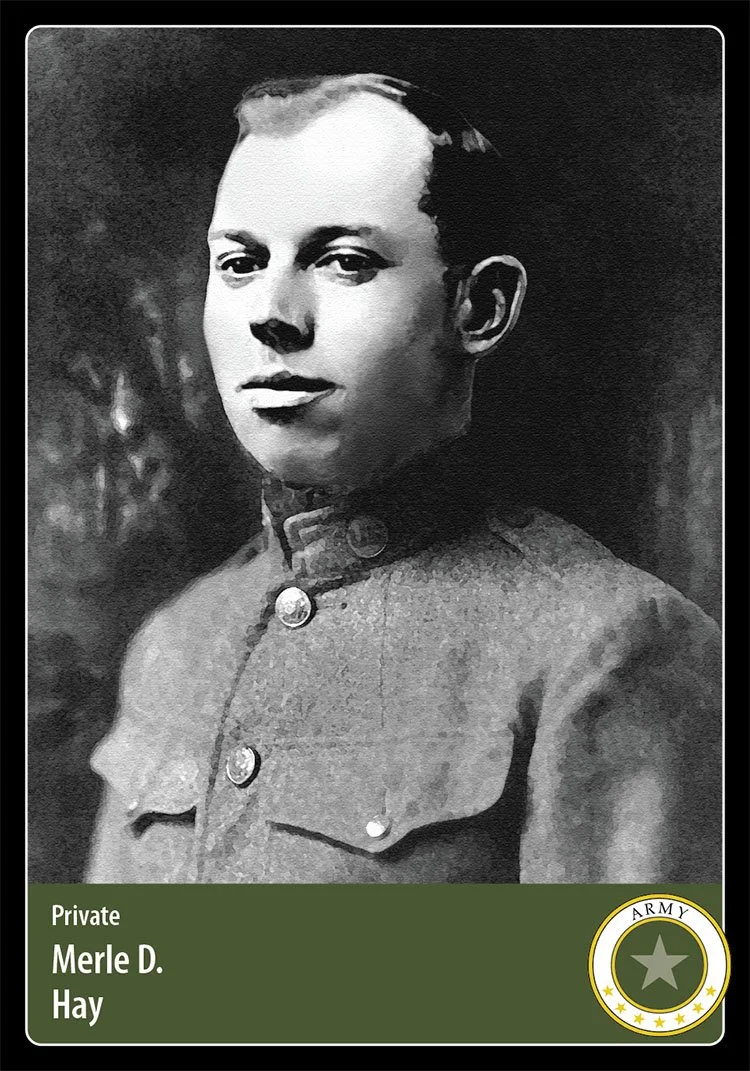Hero Card 192
Artist’s rendering by Craig Du Mez
Hometown: Glidden, IA
Branch: U.S. Army
Unit: F Company, 16th Infantry Regiment, 1st Infantry Division
Military Honors: Silver Star, Purple Heart
Date of Sacrifice: November 3, 1917 - KIA near Artois, France
Age: 21
Conflict: World War I, 1914-1918
When the United States entered World War I (1914-1918) in April 1917, the Selective Service Act became law a month later. Local boards of civilians were given the responsibility of selecting men from age 21 to 30 to serve in the military.
In the small farm town of Glidden, Iowa, an appeal went out from the local newspaper, The Glidden Graphic: “Up to the present time, to the best of our knowledge, no young man from Glidden has enlisted. Every town and community will be expected to furnish its share of young men for army and navy service so that our enemy across the seas may be brought to terms as speedily as possible.”
Merle Hay was born on July 20, 1896, to Harvey and Carrie (Cole) Hay in Carrollton, Iowa. With his younger brother Basil and sister Opal, the family moved to a different farm in nearby Glidden in 1909.
When the military draft began, Merle had not yet turned 21 and could have remained at home. Besides his work on the family farm, he had a job as a clerk and mechanic for a local farm implement store. But he and seven other young men answered the call of the town newspaper.
Merle enlisted in the United States Army on May 3, 1917. The town gathered at the Glidden Methodist church on the evening of May 7 for a “patriotic demonstration,” and again at the train depot the following morning to see the eight men off for Des Moines.
The boys from Glidden were first sent to Fort Logan, Colorado, then to Fort Bliss, Texas for training. Just three weeks after enlisting, Pvt. Hay left from the east coast on a ship bound for France.
Assigned to F Company, 16th Infantry Regiment, 1st Infantry Division, Hay and his unit trained alongside French regulars. In July of 1917, Hay wrote on the inner leaf of his Bible, “21 years old today—somewhere in France.”
A week later, his family received a letter from Pvt. Hay:
I got the picture of Basil [Merle’s younger brother] and think it is very good. I would like to be there wearing clothes like them. We sure do get tired of wearing the same kind all the time. Same old clothes, same old thing every day. But then we will not have to do it all our lives. Some day we can do as we please and say as we please, you can bet.
Goodbye from your loving son. Merle Hay
On November 1, 1917, Pvt. Hay’s unit was moved by truck closer to the trenches of the Western Front, near Artois, France. The next night at 10:00 p.m., they took up their positions, 500 yards from German lines.
According to Iowa PBS:
At about 2:30 a.m. the Germans began an artillery barrage. The men scrambled for cover. The German soldiers, taking advantage of the bombardment noise, blasted holes in the barbed wire between the American and German trenches with explosive charges. The shelling was then concentrated on the area behind the American position, cutting them off from reinforcements. At the same time 240 German infantrymen swarmed through the wire to make their assault.
The Americans were vastly outnumbered and found themselves engaged in hand-to-hand combat. Private Hoyt Decker reported seeing Pvt. Hay fighting off two German soldiers with his bayonet.
When the attack ended, five American soldiers had been wounded, twelve taken prisoner, and three killed. Private Merle David Hay was among the dead, along with Private Thomas Francis Enright and Corporal James Bethel Gresham. At age 21, Pvt. Hay was certainly the first Iowan, and quite possibly the first American to fall in “the Great War.”
Hay’s family was notified by a telegram from the War Department, which bluntly said, “Deeply regret to inform you that Private Merle D. Hay company F sixteenth infantry is reported killed in action.”
The Glidden Graphic noted that “No news ever spread more quickly about the town than this important dispatch. People were shocked with the realization that this was a real touch of War, brought very close to home.”
The three soldiers were temporarily buried in Bathelemont, France. In 1921, Hay’s body was returned to Glidden to lay in state at the American Legion building—allowing the community to pay their final respects. He was laid to rest in Glidden’s West Lawn Cemetery, where an 8-foot granite monument was raised. In Des Moines, Iowa’s capital city, Merle Hay Road was named in his honor.
Sources
Artist’s rendering by Craig Du Mez
The Glidden Graphic, November 8, 1917: Glidden Boy First American Killed in France
Iowa PBS: Private Merle D. Hay Gives His Life
Des Moines Register, November 2, 2017: From the archives: Merle Hay, Iowa’s best-known war hero, died 100 years ago
HonorStates.org: Merle David Hay
Burial Site: Find a Grave
Educate future generations, instill gratitude, honor the fallen. Join the Mission!





